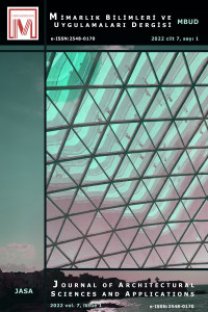İçmimarlık Eğitiminde Kavram ve Ölçek Odağı: Bir Yeniden İşlevlendirme Müze Projesi
İçmimarlık eğitimi, yeniden işlevlendirme, tasarım konsepti, ölçek, müze tasarımı
Concept and Scale Focus in Interior Design Education: An Adaptive Reuse Museum Project
Interior design education, adaptive reuse, design concept, scale, museum design,
___
- Abercrombie, S. (1990). Philosophy of Interior Design. Oxford: Westview
- Ahmad, L., Sosa, M. & Musfy, K. (2020). "Interior design teaching methodology during the global COVID-19 pandemic" All Works. 2067.
- Afacan, Y. (2016). Exploring the effectiveness of blended learning in interior design education, Innovations in Education and Teaching International, 53:5, 508-518.
- Alawad, A. (2021). Evaluating online learning practice in the interior design studio. International Journal of Art & Design Education. 10.1111/jade.12365.
- Bhattacharjee, S. (2019). Using a hybrid pedagogical method in undergraduate interior design education. Design and Technology Education: an International Journal, [S.l.], v. 24, n. 2, p. 93-109, july 2019.
- Broadfoot, O. & Bennett, R. (2003). Design studios: online? Comparing traditional face-to-face design studio education with modern internet-based design studios, Apple University Consortium Academic and Developers Conference Proceedings, s. 9-21.
- Crowther, P. (2013). Understanding the signature pedagogy of the design studio and the opportunities for its technological enhancement. Journal of Learning Design, 6(3), 18–28.
- Deasy, C. M. & Laswell, T. E. (1985). Designing Places for People: A Handbook on Human Behavior for Architects, Designers and Facility Managers. Broadway, New York.
- Demirkan, H. & Hasirci, D. (2009). Hidden dimensions of creativity elements in design process. Creativity Research Journal, Vol. 21, No. 2-3, 294-301.
- Demirkan, H. & Afacan, Y. (2012). Assessing creativity in design education: Analysis of the creativity factors in the first year design studio. Design Studies, 33, 262–278.
- Erdman, J. & Weddle, R. (2002). Designing/building/learning. Journal of Architectural Education, 55(3), 174– 179.
- Finger, A. & Follett, D. (eds.) (2011). The Aesthetics of the Total Artwork: On Borders and Fragments, The Johns Hopkins University Press.
- Harwood, B. (2013). NCIDQ's Early history: important developments from 1970 to 1990, Journal of InteriorDesign,10.1111/joid.12006,38,2, (15-33).
- Harwood, B. (2008). An interior design experience program, Part II: Developing the Experiences, Journal of Interior Design, 10.1111/j.1939-1668.1996.tb00223.x, 22, 1, (15-31).
- Hasirci, D. & Demirkan, H. (2007). Understanding the effects of cognition in creative decision making: A creativity model for enhancing the design studio process. Creativity Research Journal, 19(2-3), 259–271.
- Hennessy, S. & Murphy, P. (1999). The potential for collaborative problem solving in design and technology. International Journal of Technology and Design Education. 9. 1-36. 10.1023/A:1008855526312.
- Iranmanesh, A. & Onur, Z. (2021). Mandatory virtual design studio for all: exploring the transformations of architectural education amidst the global pandemic. International Journal of Art & Design Education. 40. 10.1111/jade.12350.
- Kent, F. (2016). Placemaking: What if we built our cities around places? The Project for Public Places. www.pps.org.
- Konkel, M. T. (2014). Build-to-learn: An examination of pedagogical practices in interior design education. Journal of Interior DesignVolume 39, Issue 2 p. 1-16.
- Koppen, E. & Meinel, C. (2015). “Empathy via Design Thinking: Creation of Sense and Knowledge.” In Design Thinking Research: Building Innovators, edited by H. Plattner, C. Meinel, and L. Leifer, 15–28. Cham, Switzerland: Springer International Publishing.
- Levent, N. & Pascual-Leone, A. (Eds.) (2014). The Multisensory Museum Cross-Disciplinary Perspectives on Touch, Sound, Smell, Memory, and Space. Lanham, MD: Rowman & Littlefield.
- Norman, D. A. (2005). Emotional design: Why we love (or hate) everyday things. New York: Basic Books.
- Norman, D. A. (2013). The design of everyday things. MIT Press.
- Okeil, A. (2010). Hybrid design environments: Immersive and non-immersive architectural design. ITcon, 15(2010), 202– 216.
- Oxman, R. (2008). Digital architecture as a challenge for design pedagogy: Theory, knowledge, models and medium. Design Studies, 29(2), 99– 120.
- Roberts, D. (2011) "The Total Work of Art in European Modernism", New York: Cornell University Press, Ithaca.
- Tuan, Yi-Fu. (2001). Space and Place: The Perspective. Mn: The University of Minnesota Press.
- WHO World Health Organization. (2020). Guidelines on physical activity and sedentary behaviour. Geneva: World Health Organization.
- Zingoni, M. (2019). Beyond aesthetics, empathy first, The Design Journal, 22: 3, 351-370.
- Zuo, Q. & MaloneBeach, E. E. (2010). A comparison of learning experience, workload, and outcomes in interior design education using a hand or hybrid approach. Family and Consumer Sciences Research Journal Volume 39, Issue 1 p. 90-106.
- Yayın Aralığı: 2
- Başlangıç: 2016
- Yayıncı: Atila GÜL
Gölcük Tabiat Parkı Rekreasyonel Kullanımının Ziyaretçiler Tarafından Değerlendirilmesi
Cengiz YÜCEDAĞ, Mehmet Şirin YELSİZ
İdeal Ses Peyzajın Planlaması ve Tasarımı
Bina Yönetmelik Alan Bilgi Gösterimleri
Mimarlıkta Çoklu Bağlamsallıklar Sorunsalı
Kamusal Açık Alanlarda Mekân Kalite Kavramının İrdelenmesi: Çanakkale Özgürlük Parkı Örneği
Alper SAĞLIK, Merve TEMİZ, Fatoş KARTAL, Dilan ŞENKUŞ
Derin Hilal BİLMEZ, Kasım ÇELİK, Cüneyt DİRİ, Ümit ARPACIOĞLU
Analitik Hiyerarşi Yöntemi ile Alternatifler Arası Otogar Yer Seçimi: Isparta Örneği
Buket EYİLETEN, Çiğdem ESENDAĞLI, Serdar SELİM
Deride Krom Oksit Tayini için Belirsizlik Hesaplaması
Sarwat MAHBOOB, Rajkumar DEWANI, Muhammad Kashif PERVEZ, Tahira AYAZ
